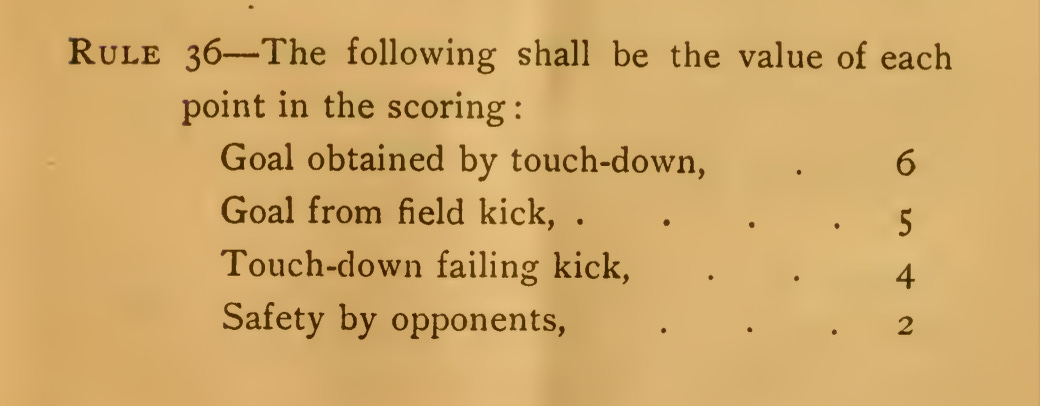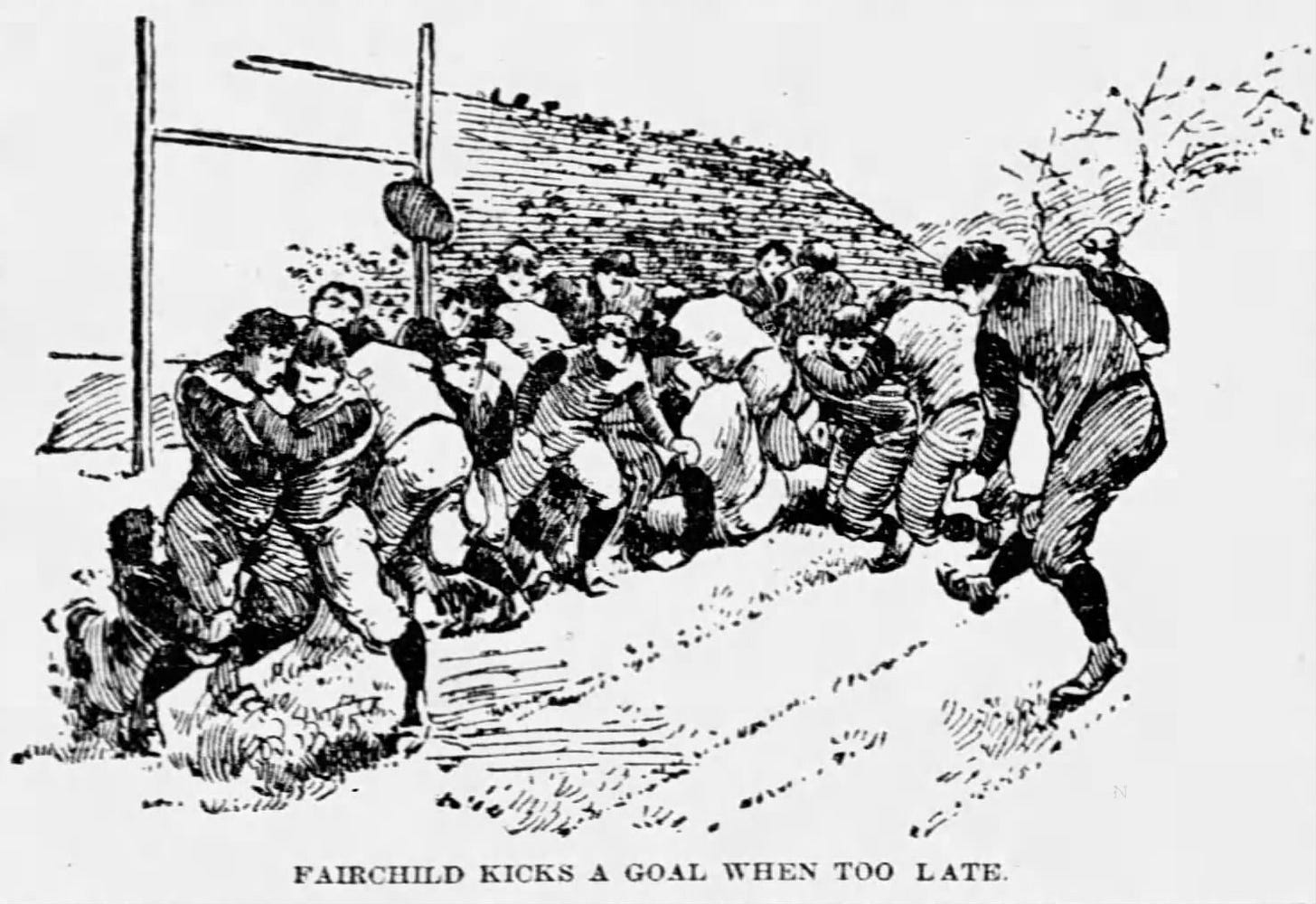Why Touchdowns Are Worth Six Points
In the beginning, there were field goals, and referees said they were good, but only when they flew over the rope strung between two posts.
Rugby and football in the 1870s were pushing, shoving, and kicking games in which the ball sometimes popped out from the mass of players in the maul, allowing a back to pick it up and run with it. Teams did not receive credit for touchdowns. Instead, touchdowns had value because they led to free kicks, while goals kicked from the field (field goals) were contested.
Football treated all goals equally. Whether kicked from the field or after a touchdown, all goals were equal, and the team kicking the most goals won the match. (The number of "safety touchdowns" helped determine the winner when teams kicked an equal number of goals.)
Walter Camp devised a points-based scoring system in 1883 that reflected how Americans playing rugby/football increasingly valued running with the ball rather than kicking it. The chart below shows the history of scoring changes in college football.
Like basketball, which values uncontested or free throws at half the value of contested field goals and now values long shots 50 percent more than shots from close to the rim, football adjusted its scoring system over time to reflect changes in the preferences of those involved in the game.
Camp's 1883 rules valued field goals at five points and goals after touchdowns at four points. Touchdowns were worth two points, and safeties were worth one point. The point values were somewhat arbitrary but reflected the belief that the combination of a touchdown and converted kick should be worth more than one field goal.
Scoring Changes of 1884
Even Walter Camp did not get things right on the first attempt, so the following year, the point system was modified to make safeties worth two points. More important, the point values of touchdowns and the goal after touchdown were switched, marking an underappreciated moment in American football's transition from rugby. Field goals remained the top priority, but running the ball into the end zone was worth two-thirds the value of a field goal, while the successful goal after touchdown was only worth one-third the same as a field goal.
Scoring Changes of 1898
By 1898, the University Athletic Club, which included representatives from the usual Eastern suspects, had the authority to make football's rules. Disagreement regarding football's direction and wearying of Eastern domination of the rulemaking process led Midwestern universities to establish a separate committee and create their own rules. However, both committees agreed to the same changes in football scoring in 1898: field goals and touchdowns were worth five points, and the goal after touchdown was worth one.
The scoring change arose from the concern that goals after touchdown had too much value, especially goals kicked from in front of the goal posts. Until 1920, teams did not always attempt the kick immediately in front of the goal posts. Instead, the location of the attempt depended on where the ball crossed the goal line on the touchdown play. Touchdowns scored in the middle of the field led to kicks from the middle, while touchdowns scored near the sideline led to goal kicks from near the sideline. Of course, teams scoring near the sideline could improve their kicking position by executing a puntout. Either way, converting the kick for some touchdowns was more difficult than others. So, they made the kick worth one "extra point" and increased the value of touchdowns by one point to equal the five points awarded for field goals.
Scoring Changes of 1904
The rules makers of 1904 reduced the value of a field goal from five points to four points. As Walter Camp explained:
This is a change that has been called for some season by many coaches and players who have always argued that it is far more difficult to make a touchdown and required more team play than to make a field goal.
'The New Rules,' Houston Post, May 19, 1904.
The rule change reinforced football's shift from a kicking game to one that valued running with the ball while emphasizing team play over the skills of a single kicker.

Scoring Changes of 1909
The 1909 rulemakers reinforced the emphasis on the importance of team play. They reduced the points for field goals from four to three, so touchdowns finally had more value than field goals.
Since football was a low-scoring game that often ended with scores in the single digits, this change often separated the winners from the losers. Under the new rule, two field goals were worth 6 points, which tied a touchdown and a converted kick. It now took three field goals to beat a touchdown and conversion.
Some in 1909 wanted field goals to be reduced to two points under the belief that kickers were born, not made, and the rules should not reward teams based on natural talent.
Scoring Changes of 1912
The final scoring change affecting the relationship between field goals and touchdowns came in 1912 when touchdowns were valued at six points. This change reflected the continued belief that teams should be rewarded for earning touchdowns rather than field goals. Now, teams in enemy territory had an additional incentive to take offensive risks that led to touchdowns rather than play it safe and attempt a field goal.
Since 1912, proposals have been made to award points for first downs or penetration of an opponent's 20-yard line. However, despite the dramatic growth of the passing game and changes in the style of play, the points awarded for touchdowns and field goals remain unchanged, and changes to their relative value have not received serious consideration.
Football Archaeology is a reader-supported site. Click here for options on how to support this site beyond a free subscription.










Looks like there is an error in the table. Safeties in 1884 were 2 points, not one. Also, I believe the one point safety was in the rules after the 1949 recodification, but it didn't appear explicitly in the table in Rule 8, Section 1. It's in Rule 8, Section 3, Article 2: "The point shall be scored if the try-for-point results in what would be a touchdown, field goal or safety under rules governing play at other times."